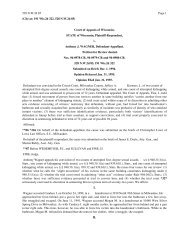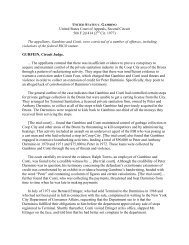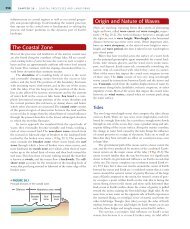Microeconomics - Cengage Learning
Microeconomics - Cengage Learning
Microeconomics - Cengage Learning
Create successful ePaper yourself
Turn your PDF publications into a flip-book with our unique Google optimized e-Paper software.
C H A P T E R<br />
17<br />
Oligopoly<br />
P R I N C I P L E S O F<br />
<strong>Microeconomics</strong><br />
N. Gregory Mankiw<br />
Premium PowerPoint Slides<br />
by Ron Cronovich<br />
© 2010 South-Western, a part of <strong>Cengage</strong> <strong>Learning</strong>, all rights reserved<br />
2010<br />
update<br />
In this chapter,<br />
look for the answers to these questions:<br />
What outcomes are possible under oligopoly?<br />
Why is it difficult for oligopoly firms to cooperate?<br />
How are antitrust laws used to foster<br />
competition?<br />
Measuring Market Concentration<br />
Concentration ratio:<br />
<br />
This chapter focuses on oligopoly,<br />
a market structure with high concentration ratios.<br />
OLIGOPOLY<br />
1<br />
2<br />
1
Concentration Ratios in Selected U.S. Industries<br />
Industry Concentration ratio<br />
Video game consoles 100%<br />
Tennis balls 100%<br />
Credit cards 99%<br />
Batteries 94%<br />
Soft drinks 93%<br />
Web search engines 92%<br />
Breakfast cereal 92%<br />
Cigarettes 89%<br />
Greeting cards 88%<br />
Beer 85%<br />
Cell phone service 82%<br />
Autos 79%<br />
Oligopoly:<br />
OLIGOPOLY<br />
Oligopoly<br />
Strategic behavior in oligopoly:<br />
A firm’s decisions about P or Q can affect other<br />
firms and cause them to react. The firm will<br />
consider these reactions when making decisions.<br />
Game theory:<br />
EXAMPLE: Cell Phone Duopoly in Smalltown<br />
P Q<br />
$0 140<br />
5 130<br />
10 120<br />
15 110<br />
20 100<br />
25 90<br />
30 80<br />
35 70<br />
40 60<br />
45 50<br />
OLIGOPOLY<br />
Smalltown has 140 residents<br />
The “good”:<br />
cell phone service with unlimited<br />
anytime minutes and free phone<br />
Smalltown’s demand schedule<br />
Two firms: T-Mobile, Verizon<br />
duopoly:<br />
Each firm’s costs: FC = $0, MC = $10<br />
4<br />
5<br />
2
EXAMPLE: Cell Phone Duopoly in Smalltown<br />
P<br />
$0<br />
5<br />
10<br />
15<br />
20<br />
25<br />
30<br />
35<br />
40<br />
45<br />
Q<br />
140<br />
130<br />
120<br />
110<br />
100<br />
90<br />
80<br />
70<br />
60<br />
50<br />
OLIGOPOLY<br />
Revenue<br />
$0<br />
650<br />
1,200<br />
1,650<br />
2,000<br />
2,250<br />
2,400<br />
2,450<br />
2,400<br />
2,250<br />
Cost<br />
$1,400<br />
1,300<br />
1,200<br />
1,100<br />
1,000<br />
900<br />
800<br />
700<br />
600<br />
500<br />
Profit<br />
–1,400<br />
–650<br />
0<br />
550<br />
1,000<br />
1,350<br />
1,600<br />
1,750<br />
1,800<br />
1,750<br />
Competitive<br />
outcome:<br />
Monopoly<br />
outcome:<br />
EXAMPLE: Cell Phone Duopoly in Smalltown<br />
One possible duopoly outcome: collusion<br />
Collusion:<br />
T-Mobile and Verizon could agree to each<br />
produce half of the monopoly output:<br />
For each firm:<br />
Cartel:<br />
OLIGOPOLY<br />
A C T I V E L E A R N I N G 1<br />
Collusion vs. self-interest<br />
P Q<br />
$0 140<br />
5 130<br />
10 120<br />
15 110<br />
20 100<br />
25 90<br />
30 80<br />
35 70<br />
40 60<br />
45 50<br />
Duopoly outcome with collusion:<br />
Each firm agrees to produce Q = 30,<br />
earns profit = $900.<br />
If T-Mobile reneges on the agreement and<br />
produces Q = 40, what happens to the<br />
market price? T-Mobile’s profits?<br />
Is it in T-Mobile’s interest to renege on the<br />
agreement?<br />
If both firms renege and produce Q = 40,<br />
determine each firm’s profits.<br />
6<br />
7<br />
8<br />
3
A C T I V E L E A R N I N G 1<br />
Answers<br />
P Q<br />
$0 140<br />
5 130<br />
10 120<br />
15 110<br />
20 100<br />
25 90<br />
30 80<br />
35 70<br />
40 60<br />
45 50<br />
OLIGOPOLY<br />
Collusion vs. Self-Interest<br />
Both firms would be better off if both stick to the<br />
cartel agreement.<br />
<br />
Lesson:<br />
It is difficult for oligopoly firms to<br />
A C T I V E L E A R N I N G 2<br />
The oligopoly equilibrium<br />
P Q<br />
$0 140<br />
5 130<br />
10 120<br />
15 110<br />
20 100<br />
25 90<br />
30 80<br />
35 70<br />
40 60<br />
45 50<br />
If each firm produces Q = 40,<br />
market quantity = 80<br />
P = $30<br />
each firm’s profit = $800<br />
Is it in T-Mobile’s interest to increase its<br />
output further, to Q = 50?<br />
Is it in Verizon’s interest to increase its<br />
output to Q = 50?<br />
9<br />
10<br />
11<br />
4
A C T I V E L E A R N I N G 2<br />
Answers<br />
P Q<br />
$0 140<br />
5 130<br />
10 120<br />
15 110<br />
20 100<br />
25 90<br />
30 80<br />
35 70<br />
40 60<br />
45 50<br />
The Equilibrium for an Oligopoly<br />
Nash equilibrium: a situation in which<br />
Our duopoly example has a Nash equilibrium<br />
in which each firm produces Q =<br />
Given that Verizon produces Q =<br />
T-Mobile’s best move is to produce Q =<br />
Given that T-Mobile produces Q =<br />
Verizon’s best move is to produce Q =<br />
OLIGOPOLY<br />
A Comparison of Market Outcomes<br />
When firms in an oligopoly individually choose<br />
production to maximize profit,<br />
oligopoly Q is _______________ monopoly Q<br />
but ______________ competitive Q.<br />
oligopoly P is _______________ competitive P<br />
but _________________ monopoly P.<br />
OLIGOPOLY<br />
12<br />
13<br />
14<br />
5
The Output & Price Effects<br />
Increasing output has two effects on a firm’s<br />
profits:<br />
Output effect:<br />
Price effect:<br />
If output effect > price effect,<br />
If price effect > output effect,<br />
OLIGOPOLY<br />
OLIGOPOLY<br />
The Size of the Oligopoly<br />
As the number of firms in the market increases,<br />
the price effect<br />
the oligopoly looks more and more like<br />
<br />
the market quantity<br />
Another benefit of international trade:<br />
Game Theory<br />
Game theory helps us understand oligopoly and<br />
other situations where “players” interact and<br />
behave strategically.<br />
Dominant strategy:<br />
Prisoners’ dilemma:<br />
OLIGOPOLY<br />
15<br />
16<br />
17<br />
6
OLIGOPOLY<br />
Prisoners’ Dilemma Example<br />
The police have caught Bonnie and Clyde,<br />
two suspected bank robbers, but only have<br />
enough evidence to imprison each for 1 year.<br />
The police question each in separate rooms,<br />
offer each the following deal:<br />
If you confess and implicate your partner,<br />
you go free.<br />
If you do not confess but your partner implicates<br />
you, you get 20 years in prison.<br />
If you both confess, each gets 8 years in prison.<br />
Clyde’s<br />
decision<br />
OLIGOPOLY<br />
OLIGOPOLY<br />
Prisoners’ Dilemma Example<br />
Confess<br />
Remain<br />
silent<br />
Bonnie’s decision<br />
Confess Remain silent<br />
Prisoners’ Dilemma Example<br />
Outcome:<br />
Both would have been better off if<br />
But even if Bonnie and Clyde had agreed before<br />
being caught to remain silent,<br />
18<br />
19<br />
20<br />
7
Oligopolies as a Prisoners’ Dilemma<br />
When oligopolies form a cartel in hopes<br />
of reaching the monopoly outcome,<br />
they become players in a prisoners’ dilemma.<br />
Our earlier example:<br />
T-Mobile and Verizon are duopolists in<br />
Smalltown.<br />
The cartel outcome maximizes profits:<br />
Each firm agrees to serve Q = 30 customers.<br />
Here is the “payoff matrix” for this example…<br />
OLIGOPOLY<br />
T-Mobile & Verizon in the Prisoners’ Dilemma<br />
Each firm’s dominant strategy:<br />
Verizon<br />
OLIGOPOLY<br />
Q = 30<br />
Q = 40<br />
Verizon’s<br />
profit = $900<br />
Verizon’s profit<br />
= $1000<br />
T-Mobile<br />
Q = 30 Q = 40<br />
T-Mobile’s<br />
profit = $900<br />
T-Mobile’s<br />
profit = $750<br />
A C T I V E L E A R N I N G 3<br />
The “fare wars” game<br />
Verizon’s<br />
profit = $750<br />
Verizon’s<br />
profit = $800<br />
21<br />
T-Mobile’s<br />
profit = $1000<br />
T-Mobile’s<br />
profit = $800<br />
The players: American Airlines and United Airlines<br />
The choice: cut fares by 50% or leave fares alone<br />
If both airlines cut fares,<br />
each airline’s profit = $400 million<br />
If neither airline cuts fares,<br />
each airline’s profit = $600 million<br />
If only one airline cuts its fares,<br />
its profit = $800 million<br />
the other airline’s profits = $200 million<br />
Draw the payoff matrix, find the Nash equilibrium.<br />
22<br />
23<br />
8
A C T I V E L E A R N I N G 3<br />
Answers<br />
United<br />
Airlines<br />
Cut fares<br />
Don’t cut<br />
fares<br />
American Airlines<br />
Cut fares Don’t cut fares<br />
Other Examples of the Prisoners’ Dilemma<br />
Ad Wars<br />
Two firms spend millions on TV ads to steal<br />
business from each other. Each firm’s ad<br />
cancels out the effects of the other,<br />
and both firms’ profits fall by the cost of the ads.<br />
Organization of Petroleum Exporting Countries<br />
Member countries try to act like a cartel, agree to<br />
limit oil production to boost prices & profits.<br />
But agreements sometimes break down<br />
when individual countries renege.<br />
OLIGOPOLY<br />
Other Examples of the Prisoners’ Dilemma<br />
Arms race between military superpowers<br />
Each country would be better off if both disarm,<br />
but each has a dominant strategy of arming.<br />
Common resources<br />
All would be better off if everyone conserved<br />
common resources, but each person’s dominant<br />
strategy is overusing the resources.<br />
OLIGOPOLY<br />
24<br />
25<br />
26<br />
9
Prisoners’ Dilemma and Society’s Welfare<br />
The noncooperative oligopoly equilibrium<br />
Bad for oligopoly firms:<br />
Good for society:<br />
In other prisoners’ dilemmas, the inability to<br />
cooperate may<br />
e.g., arms race, overuse of common resources<br />
OLIGOPOLY<br />
Another Example: Negative Campaign Ads<br />
Election with two candidates, “R” and “D.”<br />
If R runs a negative ad attacking D,<br />
3000 fewer people will vote for D:<br />
1000 of these people vote for R, the rest abstain.<br />
If D runs a negative ad attacking R,<br />
R loses 3000 votes, D gains 1000, 2000 abstain.<br />
R and D agree to refrain from running attack ads.<br />
Will each one stick to the agreement?<br />
OLIGOPOLY<br />
Another Example: Negative Campaign Ads<br />
Each candidate’s<br />
dominant strategy:<br />
Do not run<br />
attack ads<br />
(cooperate)<br />
D’s decision<br />
Run<br />
attack ads<br />
(defect)<br />
OLIGOPOLY<br />
Do not run attack<br />
ads (cooperate)<br />
no votes<br />
lost or gained<br />
D gains<br />
1000 votes<br />
R’s decision<br />
no votes lost<br />
or gained<br />
R loses 3000<br />
votes<br />
Run attack ads<br />
(defect)<br />
D loses<br />
3000 votes<br />
D loses<br />
2000 votes<br />
27<br />
28<br />
R gains 1000<br />
votes<br />
R loses<br />
2000 votes<br />
29<br />
10
Another Example: Negative Campaign Ads<br />
Nash eq’m:<br />
Effects on election outcome:<br />
Each side’s ads<br />
Effects on society:<br />
OLIGOPOLY<br />
Why People Sometimes Cooperate<br />
When the game is repeated many times,<br />
cooperation may be possible.<br />
These strategies may lead to cooperation:<br />
OLIGOPOLY<br />
Public Policy Toward Oligopolies<br />
Recall one of the Ten Principles from Chap.1:<br />
Governments can sometimes<br />
improve market outcomes.<br />
In oligopolies, production is too low and prices<br />
are too high, relative to the social optimum.<br />
Role for policymakers:<br />
OLIGOPOLY<br />
30<br />
31<br />
32<br />
11
Restraint of Trade and Antitrust Laws<br />
Clayton Antitrust Act (1914):<br />
Strengthened rights of individuals damaged by<br />
anticompetitive arrangements between firms<br />
OLIGOPOLY<br />
Controversies Over Antitrust Policy<br />
Most people agree that price-fixing agreements<br />
among competitors should be illegal.<br />
Some economists are concerned that<br />
policymakers go too far when using antitrust laws<br />
to stifle business practices that are not<br />
necessarily harmful, and may have legitimate<br />
objectives.<br />
We consider three such practices…<br />
OLIGOPOLY<br />
1. Resale Price Maintenance (“Fair Trade”)<br />
Occurs when<br />
Is often opposed because it appears to reduce<br />
competition at the retail level.<br />
Yet, any market power the manufacturer has<br />
is at the wholesale level; manufacturers do not<br />
gain from restricting competition at the retail level.<br />
The practice has a legitimate objective:<br />
OLIGOPOLY<br />
33<br />
34<br />
35<br />
12
2. Predatory Pricing<br />
Occurs when<br />
Illegal under antitrust laws, but hard for the<br />
courts to determine when a price cut is predatory<br />
and when it is competitive & beneficial to<br />
consumers.<br />
Many economists doubt that predatory pricing is<br />
a rational strategy:<br />
OLIGOPOLY<br />
Occurs when<br />
OLIGOPOLY<br />
3. Tying<br />
Critics argue that tying gives firms more market<br />
power by connecting weak products to strong ones.<br />
Others counter that tying cannot change market<br />
power: Buyers are not willing to pay more for two<br />
goods together than for the goods separately.<br />
Firms may use tying<br />
OLIGOPOLY<br />
CONCLUSION<br />
Oligopolies can end up looking like monopolies<br />
or like competitive markets, depending on<br />
The prisoners’ dilemma shows how difficult it is<br />
for firms to maintain cooperation, even when<br />
doing so is in their best interest.<br />
Policymakers use the antitrust laws to regulate<br />
oligopolists’ behavior. The proper scope of these<br />
laws is the subject of ongoing controversy.<br />
36<br />
37<br />
38<br />
13
















